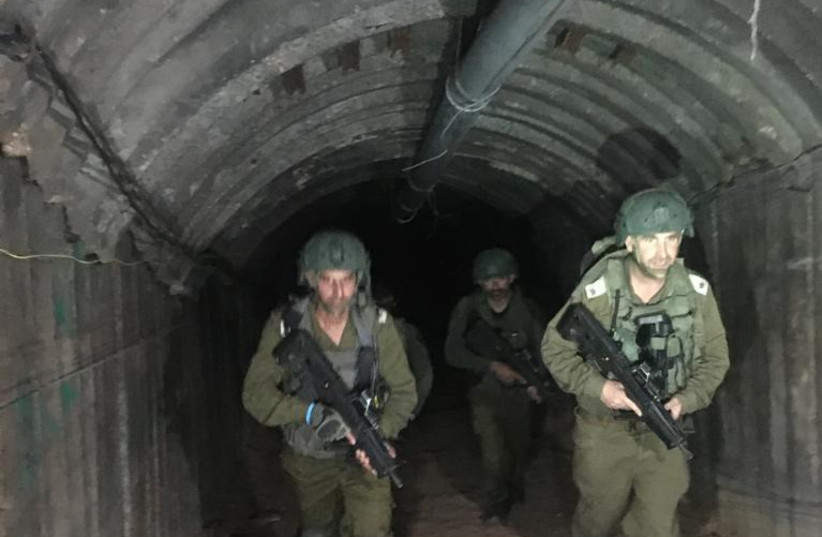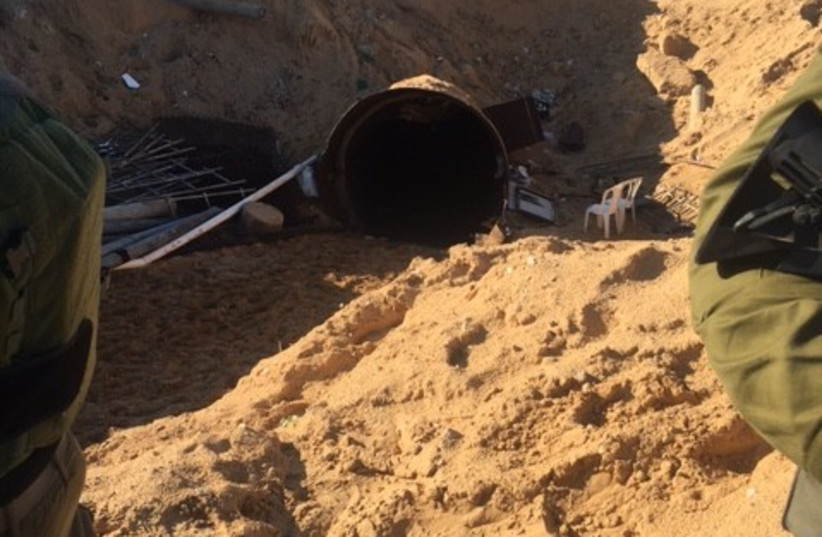IDF spokesman Daniel Hagari termed the largest Hamas terrorism tunnel just outside of the Erez Crossing the “flagship project” of the vast subterranean project used by the jihadi movement before it invaded Israel on October 7.
The Jerusalem Post inspected the tunnel last month. According to the IDF, Mohammed Sinwar, the younger brother of Hamas leader, Yahya Sinwar, supervised the construction of the tunnel.
Its width and height enabled automobiles to travel through it.

Hagari said, “We estimate it is 50 meters deep and 4km long, and have found RPGs and AK-47s stored in depots. Many smaller tunnels lead off it.”
A few days after the inspection of the Gaza tunnel, the IDF published a Hamas video showing Mohammad traveling in a small jeep with another Hamas terrorist through the tunnel.
The IDF termed the terrorist tunnel the “ Sinwar Project” and said it was not utilized on the day of the massacre, but it was in “full readiness” for an underground launch of an attack. The tunnel is a mere 400 meters from the Erez Crossing into Israel.
Col. Moshe Tetro, head of the Coordination and Liaison Administration (CLA) for Gaza, said that “the Sinwar project is meant to attack the Erez Crossing of Hope.” Tetro added that his unit’s work at Erez involved aiding Palestinians from Gaza to secure entry into Israel for medical care and employment.
The crossing was the scene of a major Hamas assault on October 7, resulting in the slaughter of 1,200 people in various locations in southern Israel. “Hamas killed three of my soldiers,” said Tetro, who added those soldiers gave permits to Gazans to enter Israel for medical aid.

Three of Tetro’s soldiers were kidnapped on October 7 from Erez. Tetro announced on the day of the Post’s tour of Gaza and the Erez Crossing that the bodies of two of his soldiers, CPL Nik Beizer from Beer Sheva, and SGT Ron Sherman from Lehavim – both 19 years old – were recovered by the IDF in Gaza.
Before entry into the tunnel, an IDF soldier showed an Arabic language poster produced by Hamas, stating that mobile phones should not be brought into the tunnel and only landline telephones should be utilized.
A thick oxygen pipe meandered its way through the tunnel along with a complex network of electrical wiring. Tetro said Hamas “took oxygen for hospitals and gave it to their terrorists to breathe underground.” Hagari noted that the IDF “will demolish” the tunnel in a few days.
IDF airstrikes pounding Gaza just a few kilometers to the south could be heard during the inspection.
Hagari stressed that “Hamas took advantage of Israel’s desire to promote prosperity in Gaza” via the benefits of the Erez Crossing. He added that if Hamas “cared about the Gazans, they would not have forced Gazans into the position of being human shields.”
The IDF declined to say if it were aware of the Sinwar tunnel before October 7. After Israel prosecutes its war against Hamas, the Sinwar project will likely be one of the topics for the government commission slated to investigate the intelligence failures surrounding Hamas’s massacre.
The role of tiny oil-rich Qatar will surely also come under the magnifying glass for its role in pumping billions of dollars into Gaza that was used by Hamas for its labyrinth of terror tunnels and its robust military apparatus.
When the Post asked about former Israeli counter-terrorism adviser Yigal Carmon’s statement that “Qatar is Hamas and Hamas is Qatar,” an IDF spokesman said “It is more complex than that,” because Qatar is also involved in the negotiations to secure the release of hostages held by Hamas in Gaza.
Carmon, who speaks fluent Arabic, served for 20 years in military intelligence and was the counter-terrorism adviser for former prime ministers Yitzhak Shamir and Yitzhak Rabin. He is the founder and president of the Middle East Media Research Institute (MEMRI).
He predicted the Hamas invasion in an article on the MEMRI website titled “Signs Of Possible War In September-October.” This journalist reported on Carmon’s prescient analysis on September 5 for Iran International.
Carmon advocates that Egypt replace Qatar as the lead mediator to secure the release of the 129 hostages held by Hamas. Qatar served as a controversial mediator when it negotiated a deal providing for the release of over 100 hostages in exchange for 240 Palestinian terrorists and criminals. Hamas kidnapped over 240 people on October 7.
As the 90th day of war came to a close, the goals of the IDF, as stressed by Hagari in December, remained the same: “To defeat Hamas and rescue the hostages.”
